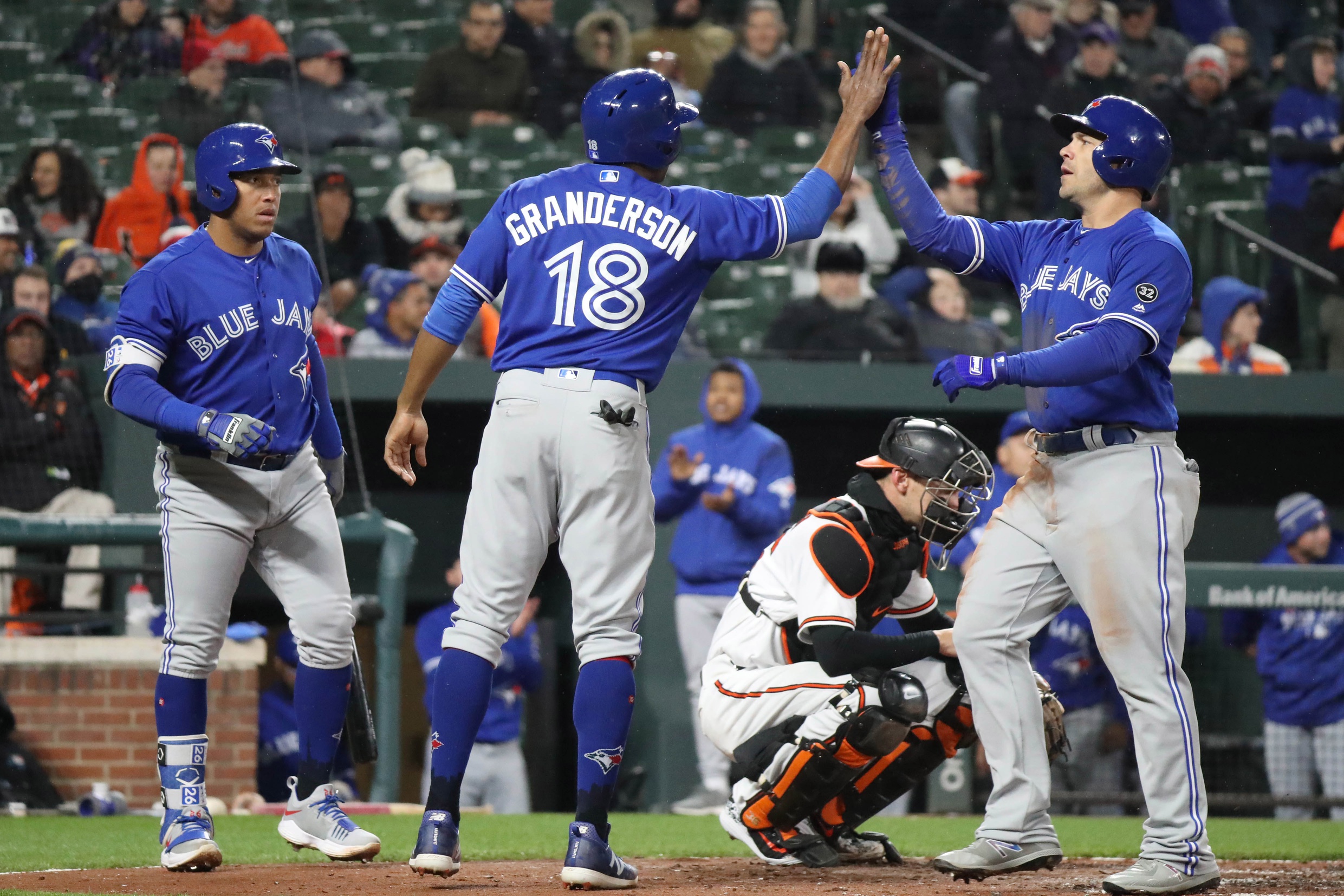The Toronto Blue Jays brought Steve Pearce into the fold in the 2016-2017 off-season with a two-year, $12.5 million deal. Following a 348 plate-appearance season that saw Pearce put up 0.1 wins’ worth of value, Curtis Granderson was brought in on a one-year, $5 million deal to be platoon-mates with Pearce.
The Granderson-Pearce platoon has combined for 0.9 fWAR to this point in the season, and with the potential to stay quite valuable at only $11.25 million between the two of them, should warrant a thank-you from Blue Jays fans to Mark Shapiro and Ross Atkins. Thank them, because this platoon is no showing signs of slowing down.
To date, Granderson has been used strictly when a right-hander is on the mound, with just five plate appearances againts left-handers compared to 69 against right-handers. Pearce has seen time at first base and DH in 2018, which has contributed to some more even splits in plate appearances against both right- and left-handed pitchers. Pearce is primarily put in left field, however, when a left-hander is on the mound. That has led to the following splits so far this year:
- Curtis Granderson vs. RHP: .303/.452/.530/.983, 171 wRC+
- Steve Pearce vs. LHP: .293/.341/.537/.877, 136 wRC+
- Combined: .298/.396/.533/.930, 153 wRC+
The left field situation angered lots of fans after the Granderson signing, as it all but solidified the platoon between him and Pearce. But they’re sure quieting the doubters so far, and there is some optimism for the platoon to continue this level of play.
Through the season’s first month, Pearce and Granderson have some interesting trends developing that could be contributing to their strong starts to the season. On 53 batted balls, Pearce has an average launch angle of 11.3 degrees. That’s the lowest of his career during the Statcast era. At the same time, he’s posted the second-highest average exit velocity and highest barrel percentage of his career, and a hard-hit percentage of 45.3.
It’s possible Pearce doesn’t need to have a high launch angle to scorch the ball and hit for power. Given how hard Pearce has hit the ball, he’s posted an xBA of .361. All of these trends are contributing to a strong start for Pearce, and as the Statcast data suggests, there’s room for growth in his actual numbers.
The Statcast numbers don’t suggest as much room for growth and improvement for Granderson, but there are some encouraging trends to his start. Granderson’s average launch angle is the lowest of his career thus far in the Statcast era, but his 40.9 percent hard-hit rate and average exit velocity of 89.1 mph are above or near his career highs. The xBA isn’t as favourable for Granderson as it is for Pearce at .250m but his ability to take walks have been contributing to a good wOBA 0f .405.
As suggested above, Pearce and Granderson are hitting well, but they’re also seeing the ball well. Both Pearce and Granderson are chasing balls at the lowest rates of their careers. Further evidence that they’re seeing the ball well: When they’re thrown meatballs, they’ve been swinging at them at rates near or above their career highs, which seems to be leading to the rise in hard contact.
Pearce and Granderson are both being attacked quite similarly by opposing pitchers, and they’re having similar rates of success with the way they’re being attacked. The table below highlights how they’ve been attacked:
Neither Pearce nor Granderson have been missing fastballs when they get them, and they have identical batting averages against breaking balls at .316. It’s interesting to note how much they both struggle against offspeed stuff. It appears that opposing pitchers may be starting to change how they attack Pearce, as 22.3 percent of the pitches he saw in April were offspend. The sample sizes of March and May are both extremely small to this point, but the percentage of offspeed pitches seen by Pearce in both months falls in the 7 to 8 percent range. Granderson, meanwhile, is seeing fewer fastballs and more breaking balls as the season goes along, but it’s encouraging to see both him and Pearce hitting the fastball as well as the breaking stuff. Pearce and Granderson both struggled mightily against breaking and offspeed pitches in 2017. We’re seeing a marked improvement thus far in 2018.
Another reason why this platoon is working out so well: They almost always have the platoon advantage against the opposing pitchers. This advantage is making traditional breaking balls less effective, and forcing pitchers to attack Pearce and Granderson with offspeed pitches like changeups and splitters to get them out instead. If they can raise their batting averages closer to their expected batting averages, they’ll become even more dangerous.
There is room for Steve Pearce to grow, and Curtis Granderson may come back down to earth a bit with his batting average, but his ability to get on-base at a great rate should keep his wOBA high. The Pearce-Granderson platoon has been everything the Jays could have wanted through the first month of the season, and there’s reason to expect this platoon to continue the success it has had. It really is a match made in heaven.
Lead Photo © Mitch Stringer-USA TODAY Sports

